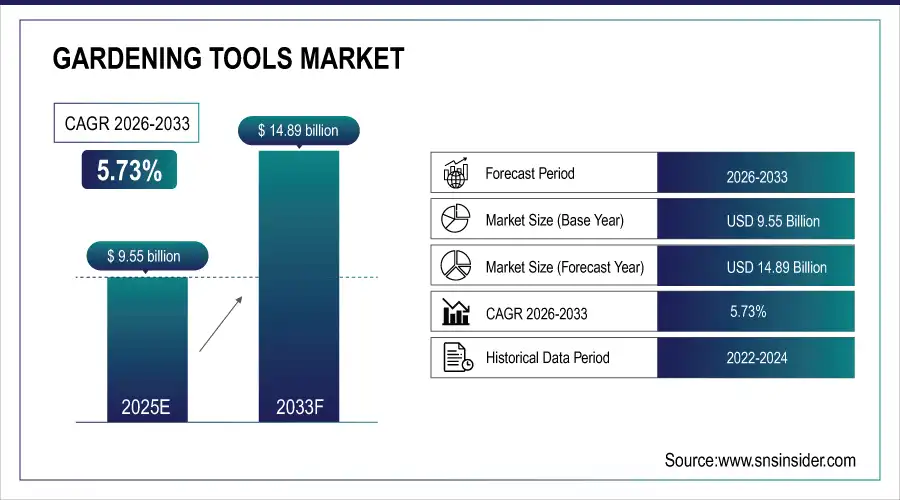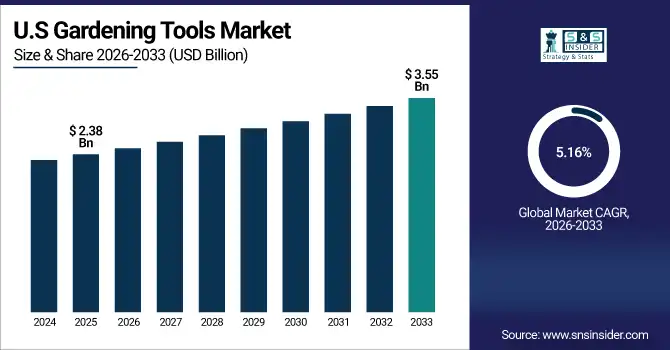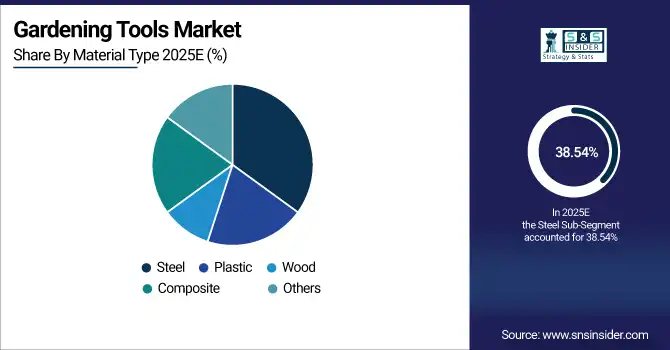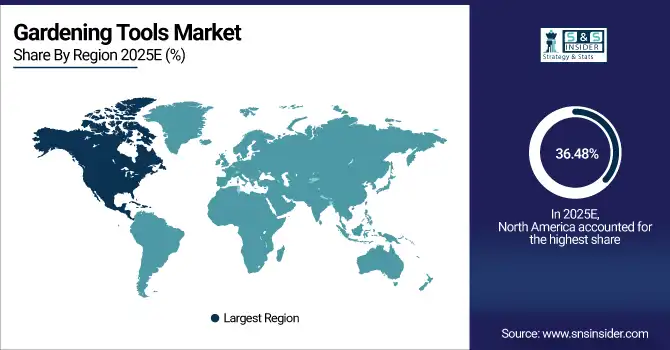Gardening Tools Market Report Scope & Overview:
The Gardening Tools Market was valued at USD 9.55 Billion in 2025E and is projected to reach USD 14.89 Billion by 2033, growing at a CAGR of 5.73% during the forecast period 2026–2033.
The Gardening Tools Market analysis provides a detailed overview of market dynamics. Rising home gardening, urban landscaping, and demand for durable, efficient tools are driving market growth, supported by increasing consumer interest, technological improvements, and adoption of modern gardening practices.
Gardening Tools adoption reached over 100 million users in 2025, fueled by residential gardens, community green spaces, and eco-friendly equipment.
Market Size and Forecast:
-
Market Size in 2025: USD 9.55 Billion
-
Market Size by 2033: USD 14.89 Billion
-
CAGR: 5.73% from 2026 to 2033
-
Base Year: 2025
-
Forecast Period: 2026–2033
-
Historical Data: 2022–2024

To Get more information On Gardening Tools Market - Request Free Sample Report
Gardening Tools Market Trends:
-
Increasing awareness regarding home gardening, urban landscaping, and environmental concerns are backing the installation of ergonomic gardening tools by industries and at residences.
-
Battery- or IOT-powered smart garden gadgets are advancing to make productive work more and labour saving, offering the intelligence for accurate gardening.
-
Government measures that support green space and urban gardening endeavours are prompting homeowners, communities and landscape contractors to invest in new garden equipment.
-
Artificial Intelligence (AI), automation and app-based monitoring are being integrated into gardening solutions for better plant care, predictive maintenance and water-efficient watering.
-
Increasing environmental consciousness and adoption of more sustainable, long-lasting, versatile tools are broadening market prospects throughout small home gardens to large commercial landscapes.
U.S. Gardening Tools Market Insights:
The U.S. Gardening Tools Market is projected to grow from USD 2.38 Billion in 2025E to USD 3.55 Billion by 2033, at a CAGR of 5.16%. Growth is supported by growing home gardening, demand for smart and power tools, urban landscaping and expanded focus on environmentally friendly products with higher value-added features.

Gardening Tools Market Growth Drivers:
-
Rising urban gardening and smart tool adoption are boosting demand for efficient, eco-friendly gardening solutions.
Rising urban gardening and smart tool adoption are driving the Gardening Tools Market growth. Within three years, it had attracted more than 120 million users involved in home gardening, urban beautification initiatives and community green projects around the world. In the US, Germany and Japan are spearheading adoption of smart battery and green tools where Municipalities and Landscaping companies are gradually introducing automation/ IoT based solutions. These trends enable higher efficiency, sustainability, and market potential, enlarging the gardening tools ecosystem overall.
In 2025, more than 95 million households and commercial projects used gardening tools, driven by rising urban gardening and sustainable landscaping.
Gardening Tools Market Restraints:
-
High upfront costs of smart and power gardening tools are limiting adoption among residential users.
The high cost of smart and power gardening tools is a key factor restraining market growth. As of 2025, 35% of residential users who wanted advanced or battery-powered tools could not afford them. Home gardeners and community gardens face more challenges deploying automation or IoT-based systems compared to a landscaping company. In addition, low levels of exposure, deficient technical support, and disparate distribution of environmental-friendly tools impede the mass implementation despite the increasing interest in urban gardening and sustainable landscaping.
Gardening Tools Market Opportunities:
-
Adoption of smart, IoT-enabled, and eco-friendly gardening tools offers significant growth potential across residential and commercial sectors.
Integration of smart, IoT-enabled, and eco-friendly gardening tools is driving market growth. As of 2025, 30 million households and commercial projects had begun to integrate connected tools for automated watering, soil monitoring and efficient landscaping, with potential for up to 85 million users by 2033. Moreover homeowners, municipalities and landscaping companies use these machines to maintain gardens efficiently with less work, turning gardening into a significant time saver, cost effect and profit builder.
Smart and IoT-enabled gardening tools accounted for 18% of new tool installations in 2025, driven by residential, commercial, and municipal users.
Gardening Tools Market Segmentation Analysis:
-
By Product Type, Hand Tools held the largest market share of 42.67% in 2025, while Power Tools are expected to grow at the fastest CAGR of 7.83%.
-
By Material Type, Steel dominated with a 38.54% share in 2025, while Composite is projected to expand at the fastest CAGR of 6.91%.
-
By Application, Residential Gardening accounted for the highest market share of 45.21% in 2025, and Urban Gardening is projected to record the fastest CAGR of 8.12%.
-
By End User, Homeowners held the largest share of 50.33% in 2025, while Municipalities are expected to grow at the fastest CAGR of 7.45%.
By Product Type, Hand Tools Dominate While Power Tools Expand Rapidly:
Hand Tools segment dominated in the market due to their affordability and widespread use in home gardens and small landscaping projects, with over 55 million active users. Specialized tools, such as trowels, pruners and rakes made for different purposes support its popularity. Power Tools segment is the fastest growing in the market and produced 18 million customers by 2025 via battery powered lawnmowers, hedge trimmers, and automation tools. Developing DIY trends, urban landscaping and labour-saving methods are also driving fast uptake.
By Material Type, Steel Dominates While Composite Expands Rapidly:
The steel segment dominated the market owing to its durability, strength, and long-life cycle for residential and commercial gardens, with 48 million units in 2025. Cost and familiarity also contribute to its supremacy. Composite segment is the fastest-growing in the market, with 12 million units in 2025, due to lightweight, rust-resistant, and ergonomic designs. Increased demand for sustainable, multipurpose tools and advances in material science is resulting in quick penetration into urban and residential gardening globally.

By Application, Residential Gardening Dominates While Urban Gardening Expands Rapidly:
Residential Gardening segment dominated the market, driven by increased home ownership, demand for DIY gardening, and personal green-space creation, with 60 million users in 2025. Open retail availability and online shopping further bolster play. Urban Gardening segment is the fastest-growing in the market, with 15 million users in 2025, fueled by community gardens, rooftop farming, and municipal initiatives. Automated irrigation systems, soil sensors and smart gardening tools are driving efficiency, sustainability and engagement for urban dwellers and market expansion driven aggressively.
By End User, Homeowners Dominate While Municipalities Expand Rapidly:
Homeowners segment dominated the market, driven by DIY gardening culture, hand tool purchases, and online or retail promotions. Strong educational initiatives and easier access to tools further support the segment, with 65 million users in 2025. Municipalities segment is the fastest growing in the market with 14 million users in 2025 due to investment in public parks, urban landscaping and IoT enabled tools. The growth and tool uptake is fuelled by government sustainability initiatives, smart city programmes and evolving budgets for maintenance of public space.
Gardening Tools Market Regional Analysis:
North America Gardening Tools Market Insights:
North America dominated the region in the Gardening Tools Market with a 36.48% market share, over 40 million users of residential, commercial and municipalities use were recognized. The region has maintained its lead due to high use of hand tools, power tools and smart gardening solutions in the region. Growth is being fuelled by government green initiatives, widespread DIY gardening culture, and easy access to e-commerce and retail channels which is building as the largest market but equally driving innovation in eco-friendly and automated garden tools.

Get Customized Report as per Your Business Requirement - Enquiry Now
U.S. Gardening Tools Market Insights:
In the U.S., growth in gardening tool usage is driven by smart, power, and eco-friendly tools, urban landscaping programs, DIY gardening trends, and government green initiatives, supported by retail and e-commerce access, with more than 25 million consumers using gardening tools in 2025, including 16 million householders and six million commercial users.
Asia-Pacific Gardening Tools Market Insights:
Asia-Pacific is the fastest-growing region in the Gardening Tools Market with a CAGR of 7.01%, owing to robust developments undertaken for urban gardening, community green projects and rising use of smart and power tools. By 2025, China contributed more than 12 million users and India around 7 million. Demand is backed by government green programs, rising awareness on DIY gardening, urban landscaping projects and growing retail and e-commerce networks in the region.
China Gardening Tools Market Insights:
China’s Gardening Tools Market growth is driven by government green initiatives, urban landscaping projects, a culture of DIY gardening, use of smarter and eco-friendly tools, and expanding retail and e-commerce penetration, serving over 12 million users in 2025, including 7 million homeowners and 3.5 million commercial projects
Europe Gardening Tools Market Insights:
Europe Gardening Tools was playing the role of host to more than 20 million users by 2025, and Germany leading the charge with over 6 million users followed by France (4.5 million) and Italy (3.8 million). Much of the residential and commercial gardening provided significant sums. Demand is being bolstered by government green drives, urban landscaping projects, the growing popularity of smart and eco-friendly equipment, DIY gardening movements and broader retail/e-tail availability in target regional markets.
Germany Gardening Tools Market Insights:
Germany’s gardening tools market growth is driven by government green initiatives, expanding urban landscaping programs, adoption of smart and sustainable technologies, and growing retail and e-commerce sectors, with over 6 million users in 2025, including 3.5 million homeowners and around 1.8 million commercial landscaping projects. Hand tools dominated the market.
Latin America Gardening Tools Market Insights:
Latin America’s Gardening Tools Market growth is driven by government green initiatives, rising DIY gardening awareness, urban landscaping projects, and expanding retail and e-commerce channels, with over 7 million users in 2025, including Brazil at 52%, Argentina at 30%, and Colombia at 18%. Residential gardening led adoption, while commercial landscaping progressed steadily.
Middle East and Africa Gardening Tools Market Insights:
Middle East & Africa Gardening Tools Market, 2025 The demand statistics turned out to be over 3 million users in 2025 wherein UAE observed users of about 1.2 million and South Africa with users around 0.9 million. Hand tools ruled and smart/eco-friendly tools were up and coming. Growth is buoyed by government green initiatives, urban landscaping projects, and growing retail and e-commerce distribution avenues.
Gardening Tools Market Competitive Landscape:
Stanley Black & Decker, a U.S.-based tools giant, dominates the gardening tools market through its hand tools, power tools, and outdoor equipment. As of 2025, more than 10 million users use their products in household and commercial landscaping. Its comprehensive portfolio of products, such as pruners, trowels, and lawnmowers, along with its incredible retail footprint, e-commerce capabilities and presence set the groundwork for its market leadership and to drive adoption of smart, durable & ergonomic gardening solutions.
-
In September 2025, Stanley Black & Decker launched the dustbuster® reveal™ product line, featuring built-in LED lights for enhanced visibility in low-light conditions. This innovation improves user experience during cleaning tasks, offering up to three times more suction power and up to 16 minutes of runtime.
Husqvarna Group, headquartered in Sweden, leads through robotic mowers, chainsaws, and power tools, serving over 8 million users in 2025. Smart automation, intelligent IoT-based solutions and green products are the engines of its domination. Strong relationships with dealers, landscapers, and government projects ensure the products' acceptance; ongoing research and design keep Kingfisher at the forefront of new developments in residential and professional gardening.
-
In February 2025, Husqvarna Group unveiled its largest launch in history, introducing 13 new boundary wire-free robotic lawnmowers for both professional and residential customers. This expansion solidifies Husqvarna's position as a leader in autonomous turf care technology.
Fiskars Group, based in Finland, commands the market with ergonomic hand tools, cutting equipment, and garden accessories, reaching over 6 million users in 2025. Emphasis on design innovation, sustainability, and reduced weight materials drive adoption. Its imposing retail presence, reach and brand prominence for quality, durability and performance gave it a reputation among home gardeners, professional landscapers and urban farmers alike.
-
In April 2025, Fiskars Group launched the Gardena EcoLine range, which includes watering products and hand-held tools made with recycled materials. Each product in this line consists of at least 65% recycled material, primarily sourced from household waste such as films or packaging.
Gardening Tools Market Key Players:
Some of the Gardening Tools Market Companies are:
-
Stanley Black & Decker
-
Husqvarna Group
-
Fiskars Group
-
Bosch
-
Toro Company
-
John Deere
-
Makita Corporation
-
Ryobi
-
Craftsman
-
Falcon Garden Tools
-
Emak Group
-
Kärcher
-
Spear & Jackson
-
Radius Garden
-
Bully Tools
-
Zenport Industries
-
Griffon Corporation
-
Gardena
-
Robomow
-
Black & Decker
| Report Attributes | Details |
|---|---|
| Market Size in 2025E | USD 9.55 Billion |
| Market Size by 2033 | USD 14.89 Billion |
| CAGR | CAGR of 5.73% From 2026 to 2033 |
| Base Year | 2025E |
| Forecast Period | 2026-2033 |
| Historical Data | 2022-2024 |
| Report Scope & Coverage | Market Size, Segments Analysis, Competitive Landscape, Regional Analysis, DROC & SWOT Analysis, Forecast Outlook |
| Key Segments | • By Product Type (Hand Tools, Power Tools, Watering Equipment, Lawn & Garden Equipment, Others) • By Material Type (Steel, Plastic, Wood, Composite, Others) • By Application (Residential Gardening, Commercial Landscaping, Urban Gardening, Organic Farming, Others) • By End User (Homeowners, Landscaping Companies, Nurseries & Garden Centers, Municipalities, Others) |
| Regional Analysis/Coverage | North America (US, Canada), Europe (Germany, UK, France, Italy, Spain, Russia, Poland, Rest of Europe), Asia Pacific (China, India, Japan, South Korea, Australia, ASEAN Countries, Rest of Asia Pacific), Middle East & Africa (UAE, Saudi Arabia, Qatar, South Africa, Rest of Middle East & Africa), Latin America (Brazil, Argentina, Mexico, Colombia, Rest of Latin America). |
| Company Profiles | Stanley Black & Decker, Husqvarna Group, Fiskars Group, Bosch, Toro Company, John Deere, Makita Corporation, Ryobi, Craftsman, Falcon Garden Tools, Emak Group, Kärcher, Spear & Jackson, Radius Garden, Bully Tools, Zenport Industries, Griffon Corporation, Gardena, Robomow, Black & Decker |

